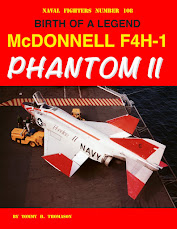The original F9F Panther nose cone had a small inlet on each side.
Early during the Korean War, there were incidents of F9F nose cones blowing off following strafing runs. It was unexpected, since the Navy had experienced nothing untoward when evaluating the Panther's 20mm guns. And Grumman didn't either when the Navy asked it to evaluate the problem, right up until the last flight of the planned test program. On that one, Corky Meyer serendipitously got the residual gun-gas conditions just right and blew his nose off, rather far away from Grumman and out over the water, as it happened.
The result was the addition of a vent in the aft end of the nose cone.
The modification was rushed out to the fleet, which accounts for the zinc-chromate primed hood over the new vent in the photo of an F9F-2 above.
This configuration was carried forward to the F9F-5.
This is neither an antenna or a handle used to pull the nose cone open as some have speculated. It was added in conjunction with the addition of the barricade forward of the existing barriers on carriers during the Korean War. It kept the inboard barrels from being snagged by the barricade straps during an engagement, which would likely have resulted in the airplane being slewed into the island or the catwalk. (For more on the barricade versus the barrier, see http://thanlont.blogspot.com/2010/10/barriers-and-barricades-one-more-time.html)
The Cougars had a different gun-gas vent. The small inlet and hooded vent were replaced by two open vents, one above the other. (The fairing on the underside of the nose covers an antenna introduced on the F9F-8 and retrofitted to some F9Fs).
The final change was the addition of an in-flight refueling probe.








No comments:
Post a Comment